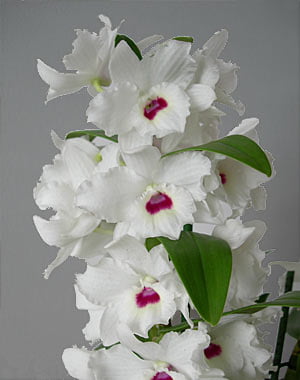The genus Dendrobium (pronounced den-DROH-bee-um ) has over 1,200 species and is geographically distributed the generally the same as Coelogynes but extend further south into Australia. Like Coelogynes they can be divided into cool and warm growing species.Dendrobiums are usually recognised because of their long cane-like pseudobulbs. Some are deciduous resembling dead twigs when dormant but from which miraculously are produced the most amazing brightly coloured flower sprays. Others are evergreen and make handsome plants all year round.Dendrobium hybrids have become popular as house plants. However you must be careful to distinguish between the warm and cool growers. Cool growers include what are often described as “nobile” types and include the wonderful species Dendrobium nobile and it’s hybrids. These typically produce their flowers close to the canes. Recommended cool growing species for beginners include D. nobile, D. thyrsiflorum, D. kingianum, D. densiflorum, D. loddigesii and D. delicatum.The warm growing species and hybrids are often referred to as “Phalaenopsis” types and these are typically more colourful than the nobile types and produce numerous short flower sprays arising out from their canes. These include the beautiful species D. phalaenopsis and the rather rudely named D. biggibum both ofwhich have been a mainstay of hybridisation.

